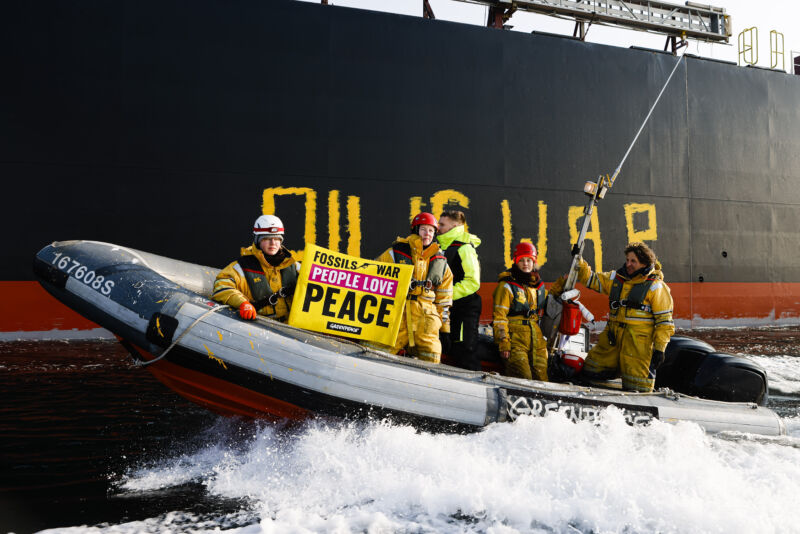
Frank Molter/photo alliance
First there was the Russian oligarch jet tracker; then there was the Russian oligarch chaser; now there is the russian oil tanker tracker.
The new tool comes from data scientists at Greenpeace UK, who have created an automated bot that draws on public data to tweet about the movements of oil and gas tankers leaving Russian ports. The goal, Greenpeace says, is to shut down one of Russia’s main sources of income fueling President Vladimir Putin’s war in Ukraine.
Russia derives significant revenues from oil and gas — about 40 percent of its federal budget relies on fossil fuel royalties — meaning tankers that honor contracts are essentially contributing to Russia’s war machine. By tweeting the origin, identity and destination of tankers docked in Russian ports, Greenpeace hopes to shame companies and countries into shunning the country’s oil and gas purchases.
“That’s a very important hypocrisy to emphasize politically,” Georgia Whitaker, an oil campaigner at Greenpeace UK, told Protocol. “Politicians say the right things, but they don’t necessarily put it into action.”
Greenpeace claims activists have already diverted a tanker bound for Sweden.
To be fair, none of the shipments are illegal yet. The Twitter bot was soft-launched on March 11, just days after President Joe Biden announced an executive order banning Russian oil and gas imports and on the same day Australia announced it would do the same. With the executive order, the Biden administration banned new contracts with immediate effect and gave existing orders 45 days to complete delivery. The UK government said it will also phase out Russian fossil fuel purchases, but is giving buyers until the end of the year to wrap things up. No EU country has banned Russian oil or gas.
Using public data
But the bot brings unprecedented transparency to an industry that tends to operate out of the public eye. The @RUTankerTracker bot uses data from MarineTraffic, the shipping equivalent of a flight tracking website. The site uses the computerized identification system (AIS) that all large vessels (over 300 tons) or passenger vessels must use.
AIS is intended as a navigational aid in addition to radar. Ships broadcast their GPS-determined locations on VHF frequencies. Other ships within a radius of about 37 miles can pick up the signals and map them against themselves and other ships in the area. AIS can also transmit other sensor data, including rotational speed, pitch and roll, and so on. Greenpeace data scientists also use financial data sources such as Bloomberg and Refinitiv to determine a ship’s cargo and destination.
Using all that data, the tracker can determine which ships are docked in Russian ports, announce updates to their routes and make it public. where they go based on their reported destination.
But even with all that data, the tracker comes with a disclaimer: Tracking oil tankers is harder than tracking planes. Sometimes those routes changeHowever, for several reasons: ships may change destinations depending on the price of oil or gas, or they may have left port without a destination in the first place. “We have done this work as a quick response to the attack on Ukraine,” Greenpeace said in a pinned-down statement tweet† †[O]your bot isn’t perfect and neither are we, but at least we didn’t illegally invade anyone else’s country.”
walking in the dark
However, the tanker bot faces a new challenge, one that governments that impose sanctions will also find difficult to overcome. Windward, an Israeli maritime risk consultancy, says at least 33 Russian tankers turned off their AIS transponders last week, at twice the average rate for the past year, according to a Bloomberg report. Most of the “dark” operations took place near Russian shores. In some cases, Windward tracked ships as they hung out alongside other tankers for a few hours, possibly transferring oil from one to the other.
This behavior is not new. A few years ago, Russian ships were caught turning off their transponders to deliver oil to Syria, the US Treasury Department said:[V]Essels transporting petroleum to Syria have been known to disable their AIS transponders to mask their movements.”
International maritime law requires tankers and other commercial vessels to keep their transponders on while at sea, and while that may not prevent captains or owners who want to break the law, it does help narrow the search for ships participating in illegal activities. . “There’s no reason they should turn off their AIS,” Windward’s Gur Sender told Bloomberg.

